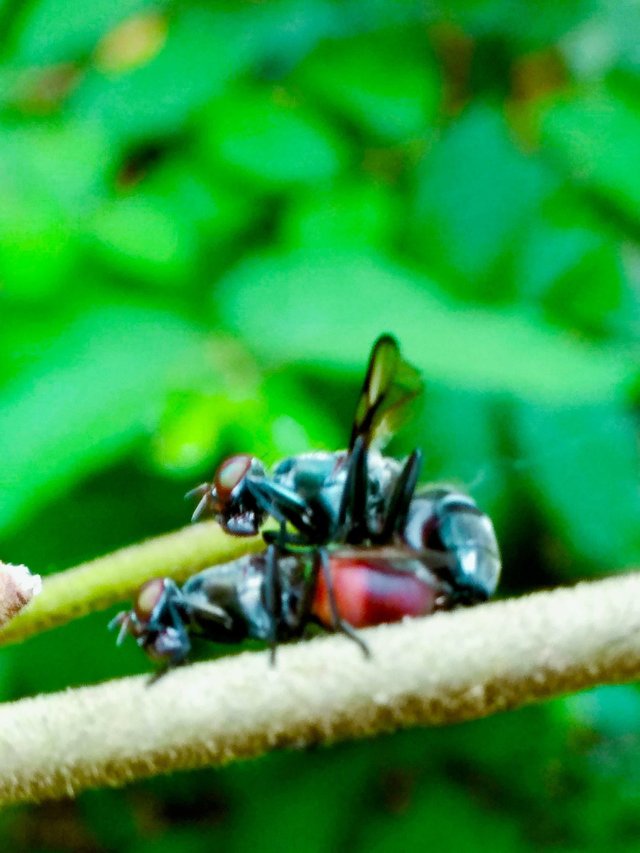The life of a loving fly. (married) as if the world belongs to both of them 
HOW REPRODUCTION, DEVELOPMENT AND METAMORFOSIS ON FLY
The female flies genitals are rotated to some degree from positions found in other insects. In some flies, this is temporary rotation during mating, but on the other, it is the permanent torque of organs that occur during the cocoon stage. This torsion may cause the anus located beneath the genitals, or, in the case of 360 ° of torque, on the sperm ducts that wrap around the intestine, even though the external organs are in their usual position. When the mating flies, the male initially flies over the female, facing the same direction, but then turns to face in the opposite direction.
This forces the man to lie on his back for his genitals to stick to the female flies, or the torque of the male genitals allows the male partner to temporarily stay upright. This causes flies to have more reproductive ability than most insects, and at a much faster rate. Flies occur in large populations because of their ability to mate effectively and in the shortest time during the breeding season.
The female puts its eggs close to the food source (as in almost ripe fruit), allowing the larvae to consume as much food as possible in a short time before it matures. Eggs hatch as soon as laid, or flies are ovoviviparous, with hatching of larvae within the parent body.
Fly larvae do not have the correct legs. Some of the Dipedish larvae, such as the Simuliidae, Tabanidae, and Vermileonidae species, have prolegas adapted to functions such as holding onto a substrate in flowing water, holding a host tissue, or holding prey. Roughly, there are some anatomical differences between larvae of Nematocera and Brachycera (see Classification, below), especially in Brachycera, there is a slight demarcation between the chest and abdomen, although the demarcation may be highly visible in many Nematocera, such as mosquitoes (see picture, both here and in mosquito articles), in Brachycera, the head of this larva is not clearly distinguished from other body parts, and there are few, if any, sclerites. Informally, as Brachyceran larvae are called maggots. But the term is often used nontechnical and indifferent to fly larvae or insect larvae in general. Brachyceran's eyes and antennae are diminished or absent, and the stomach also does not have a complement like Cerci. The lack of features is an adaptation to foods such as carcasses, decaying detritus, or tissue hosts surrounding larval endoparasites. Nematoceran generally has a visible eye and antenna, although it is usually small and functionally limited.
Metamorphosis of flies starts from eggs of fertilization. Flies have a higher reproduction rate when compared to other insects. In addition, the rate of production is also more than other types of insects. This is due to their ability in terms of very efficient marriage is also effective especially in the breeding season. After the fertilization process, the mother fly will lay eggs. Usually he attaches his eggs to a food source such as fruit that is almost rotten. Then the next development is the change of eggs into larvae.
The metamorphosis of flies characterized by the change of eggs into larvae is divided into two periods namely the embryonic period and the postembrionic developmental period. The embryonic period is the phase in which the flies fertilize and then produce eggs which then hatch into young larvae within just 24 hours. This larval hatching occurs inside the place where the mother lays the egg. These fly larvae are sometimes called maggots. In this phase, the young larvae does not stop feeding and prepare itself into the subsequent metamorphosis period of post embryonic.
What is meant by post embryotic is the period after the egg turns into a larva.
The larva itself is divided into three parts:
instar larvae I,
instar larvae II,
and instar larvae III.
The distribution of larvae is based on the process of skin change in larvae that did occur 3 times with a period of 7 to 10 days per change. After the instar period is complete, the metamorphosis of the fly will enter the pupa or cocoon phase and then subsequently become an imago or sexual phase marked on the development of the wing until it becomes a fly with a perfect body.
As animals with perfect metamorphosis, flies through the pathway of life:
Follow@sonia12
Upvotes yes
Your comments I wait
😂💐
You make a good post, I love it. I'm not experienced like you. here is the upvote for you. To get more upovet, please follow me @agamitam and check my post. To comment so I can like @ sonia12
Thank you
Downvoting a post can decrease pending rewards and make it less visible. Common reasons:
Submit
Thank you @agamitam..
Downvoting a post can decrease pending rewards and make it less visible. Common reasons:
Submit
The perfect post ..
You can still fly flies. Good again potografynya. Using what camera?
Downvoting a post can decrease pending rewards and make it less visible. Common reasons:
Submit
@katrinadewi
I just use hp camera. And the macro lens .. That flies his arrogant. Not long there .. Direct run
Downvoting a post can decrease pending rewards and make it less visible. Common reasons:
Submit
Napa gak beli vote ja, sayang gambarnya cantek gak da yang ngevote. Follow me @abisumayyah
Downvoting a post can decrease pending rewards and make it less visible. Common reasons:
Submit